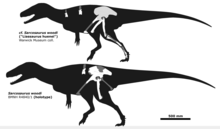Sarcosaurus
| Sarcosaurus | |
|---|---|

| |
| Skeletons of the known specimens of Sarcosaurus woodi (restored as a ceratosaur) | |
| Scientific classification | |
| Domain: | Eukaryota |
| Kingdom: | Animalia |
| Phylum: | Chordata |
| Clade: | Dinosauria |
| Clade: | Saurischia |
| Clade: | Theropoda |
| Clade: | Neotheropoda |
| Genus: | †Sarcosaurus Andrews, 1921 |
| Type species | |
| †Sarcosaurus woodi Andrews, 1921
| |
| Synonyms | |
| |
Sarcosaurus (
Description

The holotype is NHMUK PV R4840 a partial skeleton that includes a posterior
History of discovery

The
Between the years 1980 and 2000, three fossils were discovered on a beach near
In 2023, a partial Theropod Specimen recovered from the lower Sinemurian Broadford Beds Formation of the Isle of Skye, previously referred to a Coelophysoid-grade theropod, was reclassified as Cf.Sarcosaurus, clading with Tachiraptor as a branch leading to Averostra. This specimen, NMS G.1994.10.1, consists on an isolated left tibia lacking its proximal region.[12]
Phylogeny

Andrews originally assigned Sarcosaurus to the Megalosauridae. The first to suggest a more basal position was Samuel Paul Welles who placed it in the Coelophysidae.[13] Later analyses resulted in either a position in the Ceratosauria,[14] or in the Coelophysoidea.[15] Ezcurra (2012) found Sarcosaurus to be the most basal ceratosaur in a large unpublished analysis.[16] In 2018, Andrea Cau in the large analysis of Saltriovenator found Sarcosaurus to be a dilophosaurid with good amount of support in the data.[17] In 2020, Ezcurra et al. recovered Sarcosaurus as a close relative of Averostra due to the presence of shared characters including an anteroventrally oriented ventral margin of the preacetabular process in lateral view on the ilium and a femur with a poorly posteriorly developed fourth trochanter. Their cladogram is shown below:[1] A latter work reinforced that clade made of Sarcosaurus woodi + (Tachiraptor admirabilis + Averostra).[12]
Palaeoenvironment
Holotype specimen was collected from strata (bucklandi zone, Sinemurian) that were deposited in epicontinental, shallow, marine settings affected by sea-level fluctuations and a warm, predominantly humid climate.
See also
References
- ^ hdl:11336/160038.
- ISSN 0028-3630.
- S2CID 243596687, retrieved 2023-10-19
- ISSN 0374-5481.
- ^ Von Huene, F. (1932). "Die fossile Reptil-Ordnung Saurischia, ihre Entwicklung und Geschichte". Monographien zur Geologie und Paläontologie. 1 (4): 361. Retrieved 19 October 2023.
- ISSN 0374-5481.
- JSTOR 1440541.
- ^ Waldman, M. (1974). "Megalosaurids from the Bajocian (Middle Jurassic) of Dorset". Paleontology. 17 (2): 325–339. Retrieved 19 October 2023.
- S2CID 129624992.
- ^ Pickering, S. (1995). Jurassic Park: Unauthorized Jewish Fractals in Philopatry. A Fractal Scaling in Dinosaurology Project (2 ed.). Capitola. p. 478.
{{cite book}}: CS1 maint: location missing publisher (link) - S2CID 228811170.
- ^ S2CID 264343748.
- ^ Welles, S.P. (1984). "Dilophosaurus wetherilli (Dinosauria, Theropoda): osteology and comparisons". Palaeontographica Abteilung A. 185: 85–180. Retrieved 19 October 2023.
- ^ Gauthier, J. A. (1986). "Saurischian monophyly and the origin of birds". Memoirs of the California Academy of Sciences. 8 (1): 1–55. Retrieved 19 October 2023.
- S2CID 30039789.
- ^ Ezcurra, M. (2012). "Phylogenetic analysis of Late Triassic – Early Jurassic neotheropod dinosaurs: Implications for the early theropod radiation". Journal of Vertebrate Paleontology. Program and Abstracts. 32: 1–91.
- PMID 30588396.
- ISSN 0016-7878.
- ISSN 0016-7878.
- S2CID 133014351.
- ^ Radley, J.D. (2003). "Warwickshire's Jurassic geology, past,present and future" (PDF). Mercian Geologist. 15 (1): 209–218. Retrieved 19 October 2023.
- ^ Cox, BM; Sumbler, MG; Ivimey-Cook, HC (1999). "A formational framework for the Lower Jurassic of England and Wales (onshore area)". British Geological Survey Research Report. 99 (1): 1–28. Retrieved 19 October 2023.
